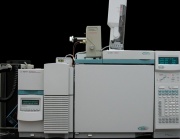Gas chromatography
Description
An analytical technique for the qualitative and quantitative analysis of organic materials with boiling points below 550 C. Compounds with higher boiling points can be analyzed after chemical modifications, such as silylation. Gas chromatographs with mass spectrometer detectors can provide positive identification of compounds at the low parts per billion level. The sample, a gas or volatilized liquid, is injected through a port into a flowing stream of inert carrier gas such as helium, argon or nitrogen. The samples and carrier gas pass through a column which contains a stationary phase that separates the sample components through a gas-liquid partitioning process. The separated components are flushed sequentially from the column to a detector. Available detectors are flame ionization (FID), thermal conductivity (TCD), electron capture (ECD) and mass spectrometry (MS). The elapsed time from injection to detection is defined as the retention time for an individual species. Identification and quantification of the sample's components are achieved by comparison of their retention times and peak areas to those of reference standards analyzed under the same conditions.
Synonyms and Related Terms
GC; Gaschromatographie (Deut.); chromatographie en phase gazeuse (Fr.);
Authority
- External source or communication, External source or communication Comment: Submitted information from Walter Hopwood
